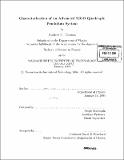Characterization of an advanced LIGO quadruple pendulum system
Author(s)
Thomas, Andrew C. (Andrew Christopher), 1981-
DownloadFull printable version (1.735Mb)
Alternative title
Characterization of an advanced laser interferometer gravitational-wave observatory quadruple pendulum system
Other Contributors
Massachusetts Institute of Technology. Dept. of Physics.
Advisor
Nergis Mavalvala.
Terms of use
Metadata
Show full item recordAbstract
The Laser Interferometer Gravitational-wave Observatory (LIGO) measures relative displacements of the interferometer mirrors induced by passing gravitational waves (GWs). At low frequencies, typically below 30 Hz, seismic noise is the dominant noise source that limits the sensitivity with which GW-induced mirror displacements can be measured. To shield the mirrors from the seismically driven motion of the ground, they are suspended from pendula which are in turn mounted on optical platforms with vibration isolation systems. The Advanced LIGO goal for strain sensitivity is factor of 10 to 15 lower than that for Initial LIGO. This requires improved seismic isolation techniques to reduce the seismic noise limit by this factor. This is being achieved in two ways: active vibration isolation of the optical platform on which the suspended mirrors are mounted; and suspension of the interferometer mirrors from the final stage of multiple pendula. In this thesis we characterize the dynamics of a prototype quadruple pendulum system. The figure of merit in evaluating and improving the performance of the quadruple pendulum is the motion of the mirror at frequencies between 1 and 100 Hz. To determine this, it is necessary to measure the frequency response (transfer functions) of the mirror displacement to motion of the penultimate mass of the pendulum. We describe the construction of a sensing and actuation system used to measure the transfer functions between the third and fourth masses, toward the ultimate goal of exploring the possibilities of third-mass system control. The measured transfer functions were compared to theoretical predictions generated by a simplified computer simulation of the complex system.
Description
Thesis (S.B.)--Massachusetts Institute of Technology, Dept. of Physics, 2004. Includes bibliographical references (leaf 43).
Date issued
2004Department
Massachusetts Institute of Technology. Department of PhysicsPublisher
Massachusetts Institute of Technology
Keywords
Physics.